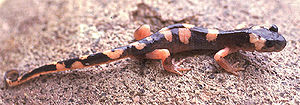
Ensatina
Encyclopedia
Ensatina eschscholtzii (commonly known by its genus name, Ensatina) is a complex of plethodontid (lungless) salamander
s found in coniferous forests, oak woodland and chaparral
from British Columbia
, through Washington, Oregon
, across California
(where all seven subspecies variations are located), all the way down to Baja California
in Mexico
.
in the mountains surrounding the Californian Central Valley. The complex forms a horseshoe
shape around the mountains, and though interbreeding can happen between each of the 19 populations around the horseshoe, the Ensatina eschscholtzii subspecies on the western end of the horseshoe cannot interbreed with the Ensatina klauberi on the eastern end. As such it is thought to be an example of incipient speciation, and provides an illustration of "nearly all stages in a speciation process" (Dobzhansky,1958).
Males often have longer tails than the females, and many of the salamanders have lighter colored limbs in comparison to the rest of the body. The salamanders lay their eggs underground, often in threes, which then hatch directly into salamanders, skipping the usual aquatic phase.

Salamander
Salamander is a common name of approximately 500 species of amphibians. They are typically characterized by a superficially lizard-like appearance, with their slender bodies, short noses, and long tails. All known fossils and extinct species fall under the order Caudata, while sometimes the extant...
s found in coniferous forests, oak woodland and chaparral
Chaparral
Chaparral is a shrubland or heathland plant community found primarily in the U.S. state of California and in the northern portion of the Baja California peninsula, Mexico...
from British Columbia
British Columbia
British Columbia is the westernmost of Canada's provinces and is known for its natural beauty, as reflected in its Latin motto, Splendor sine occasu . Its name was chosen by Queen Victoria in 1858...
, through Washington, Oregon
Oregon
Oregon is a state in the Pacific Northwest region of the United States. It is located on the Pacific coast, with Washington to the north, California to the south, Nevada on the southeast and Idaho to the east. The Columbia and Snake rivers delineate much of Oregon's northern and eastern...
, across California
California
California is a state located on the West Coast of the United States. It is by far the most populous U.S. state, and the third-largest by land area...
(where all seven subspecies variations are located), all the way down to Baja California
Baja California Peninsula
The Baja California peninsula , is a peninsula in northwestern Mexico. Its land mass separates the Pacific Ocean from the Gulf of California. The Peninsula extends from Mexicali, Baja California in the north to Cabo San Lucas, Baja California Sur in the south.The total area of the Baja California...
in Mexico
Mexico
The United Mexican States , commonly known as Mexico , is a federal constitutional republic in North America. It is bordered on the north by the United States; on the south and west by the Pacific Ocean; on the southeast by Guatemala, Belize, and the Caribbean Sea; and on the east by the Gulf of...
.
As a ring species
The Ensatina salamander has been described as a ring speciesRing species
In biology, a ring species is a connected series of neighboring populations, each of which can interbreed with closely sited related populations, but for which there exist at least two "end" populations in the series, which are too distantly related to interbreed, though there is a potential gene...
in the mountains surrounding the Californian Central Valley. The complex forms a horseshoe
Horseshoe
A horseshoe, is a fabricated product, normally made of metal, although sometimes made partially or wholly of modern synthetic materials, designed to protect a horse's hoof from wear and tear. Shoes are attached on the palmar surface of the hooves, usually nailed through the insensitive hoof wall...
shape around the mountains, and though interbreeding can happen between each of the 19 populations around the horseshoe, the Ensatina eschscholtzii subspecies on the western end of the horseshoe cannot interbreed with the Ensatina klauberi on the eastern end. As such it is thought to be an example of incipient speciation, and provides an illustration of "nearly all stages in a speciation process" (Dobzhansky,1958).
Habitat and description
The Ensatina subspecies E. e. eschscholtzii, or Monterey Ensatina, can be found in Santa Cruz, Monterey, and the California coastal mountains. They reach a total length of three to five inches, and can be identified primarily by the structure of the tail, and how it is narrower at the base. This salamander is the only type that has this tail structure and five toes on the back feet.Males often have longer tails than the females, and many of the salamanders have lighter colored limbs in comparison to the rest of the body. The salamanders lay their eggs underground, often in threes, which then hatch directly into salamanders, skipping the usual aquatic phase.
Human contact
The ensatina can usually be found under logs, brush, by or in streams and lakes, and in other moist places. Because they breathe through their pores, distress in the animal can be caused by improper handling by human hands. They may exude a toxic milky secretion from the tail.
Subspecies
- Yellow Blotched Ensatina — E. e. croceater (Cope, 1868)
- Monterey Ensatina — E. e. eschscholtzii Gray, 1850
- Large Blotched Ensatina — E. e. klauberi Dunn, 1929
- Oregon Ensatina — E. e. oregonensis (Girard, 1856)
- Painted Ensatina — E. e. picta Wood, 1940
- Sierra Nevada Ensatina — E. e. platensis (Jiménez de la Espada, 1875)
- Yellow Eyed Ensatina — E. e. xanthoptica Stebbins, 1949
External links
- Ensatina Salamander page at Santa Rosa Junior College Department of Life Sciences
- Ensatina Salamander page at AmphibiaWeb

